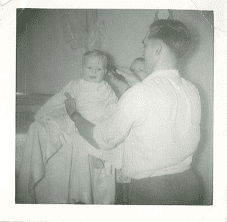 Here’s the first buzz of my square head, administered by my dad with big sister peaking in.
Here’s the first buzz of my square head, administered by my dad with big sister peaking in.
Oh, my, how many more head buzzes I’ve had. Oh, my, how far we’ve come.
That applies to American Zen too.
This comes up for me today as I prepare for the Zen Priest Home-Leaving: Spirit, Principles, and Possibilities workshop at the Boundless Way Temple, coming up in a couple weeks.
What are some of the differences between American Zen and it’s predecessors in Asia, particularly Soto Zen?
There’s an emphasis here on mindfulness and moral precepts, of course, but I’m not going there today.
Where I will go, ever so briefly, is to the exclusive humanism dimension to our practice that may be unique in human history (that’s from Hondo – see below).
What is “exclusive humanism?”
I recently watched a presentation of Zen form on YouTube, where the presenter says that the forms of our practice – clothing, sitting, bowing, bells, and chanting – are there to support our practice. That’s exclusive humanism.
Practice is all about us?
If the forms are seen as being there to support me, then they appear rather arbitrary. I might not feel all that supported about bowing or sitting in accord with the traditional instructions. If it’s all about me, why don’t I just do it my way?
Maybe it depends on who or what the support is coming from. If the support is coming from me doing something and going to me … well, again, it’s all about me. Exclusive humanism.
Another view is that we are here to preserve the buddhadharma for the helpless ones of the future and part of how we do that is to let go of our incessant self obsession and just wear the robe, just sit, just bow, just become the koan. Just for a moment or two now and then.
Another related view is that through receiving and embodying the form from our teachers, we bring the buddhas and ancestors to life now. Support is coming from buddhas and ancestors and going to buddhas and ancestors, flavorlessly and holochronically.
For another aspect of this see this excellent post by Hondo Dave over at No Zen in the West. Here’s a taste:
“If the best human life is one marked by exclusively human flourishing, then bodhisattva practice is about improving human lives with reference only to human lives–making sure people are fed and clothed, that our illnesses are treated, that we have shelter and community and so on. That we’re happy, as happiness is generally understood. On the other hand, there’s something very deep and very basic in the Dharma that points to the unsatisfactoriness of precisely all those things. The First Noble Truth is a pretty serious attack on the “good” things in a human life–family, friends, work. All of that, a piece of our tradition whispers, is in some way not-enough. Even in Zen, we call a priest ordination a home-leaving, right? To mark precisely the fact that even a home, even a happy, stable, loving home, is somehow not the entirety of a life. That there is a source of meaning which is in reference to something else.”











